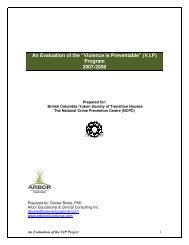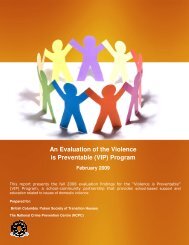reducing barriers to support - BC Society of Transition Houses
reducing barriers to support - BC Society of Transition Houses
reducing barriers to support - BC Society of Transition Houses
Create successful ePaper yourself
Turn your PDF publications into a flip-book with our unique Google optimized e-Paper software.
e secluded and forced <strong>to</strong> use men’s washrooms. Mottett and Ohle, advocates with the National Gay<br />
and Lesbian Task Force in the United States suggest that residences start with a policy <strong>of</strong> respect that<br />
includes treating people according <strong>to</strong> the gender they identify with or acknowledging that people “are<br />
who they say they are”. 60<br />
Misinformation and harmful stereotypes about trans people may lead <strong>to</strong> concerns about safety. But as<br />
one advocate puts it:<br />
“Stereotypes <strong>of</strong> transgender people attacking women come from movies and television<br />
shows that inaccurately portray transgender people as dangerous and abusive. This is far<br />
from the truth. When it comes <strong>to</strong> transgender people, the more serious risk is that<br />
violence will be committed against transgender people by others. Also, shelters need <strong>to</strong><br />
learn that it is a myth that woman-only space is always safe. The occurrence <strong>of</strong> woman<strong>to</strong>-woman<br />
abuse by both straight and lesbian women is real, and shelters need clear<br />
rules against it. By enforcing these rules for all residents, transgender and nontransgender,<br />
these spaces can become truly safe.” 61<br />
PREGNANCY AND MOTHERING<br />
While pregnant and mothering women who experience violence are <strong>of</strong>ten viewed sympathetically,<br />
predominant messages around mothering have lead women whose mental wellness or substance use is<br />
impacted by violence <strong>to</strong> be labeled as abusers themselves. 62 Greaves and Poole have pointed out that<br />
service providers working with mothers and pregnant women <strong>of</strong>ten focus on the child or fetus at the<br />
expense <strong>of</strong> the woman and the context she is operating within. 63 Women with varying levels <strong>of</strong> mental<br />
wellness and substance use are frequently perceived as “bad mothers” even though they may treat their<br />
children well. Consequently, women who are mothers may be hesitant <strong>to</strong> seek <strong>support</strong> for violence they<br />
are experiencing, mental wellness or substance use for fear <strong>of</strong> having their children apprehended by<br />
child protection services.<br />
Pregnant women or women who are mothers seeking <strong>support</strong> for mental wellness and, especially,<br />
substance use will find few resources available specific <strong>to</strong> their needs. 64 Often residential programs do<br />
not accommodate children and women rarely want <strong>to</strong> leave their children behind, especially if they are<br />
leaving a violent situation. Even in the Violence Against Women’s sec<strong>to</strong>r, service providers have<br />
13






